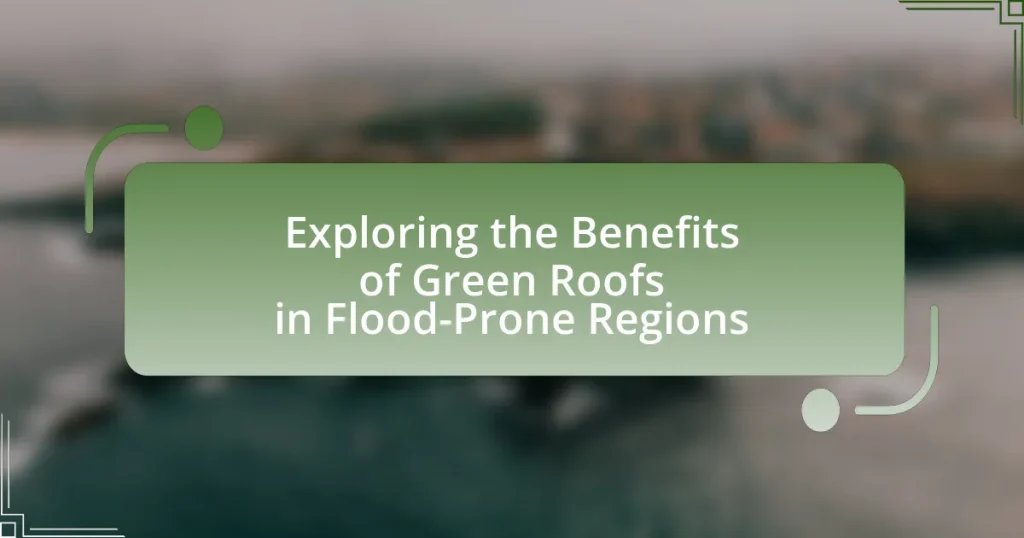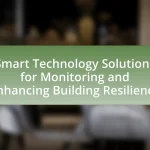Green roofs are vegetated surfaces installed on rooftops that provide significant environmental benefits, particularly in flood-prone regions. They effectively manage stormwater by absorbing rainfall, which reduces runoff and mitigates flooding risks, with studies indicating they can retain up to 80% of precipitation during rain events. The article explores the key components of green roof systems, their role in enhancing urban biodiversity and air quality, and the economic advantages they offer, including reduced energy costs and increased property value. Additionally, it addresses the specific challenges faced by flood-prone areas and outlines best practices for designing and maintaining green roofs to maximize their effectiveness in flood management.
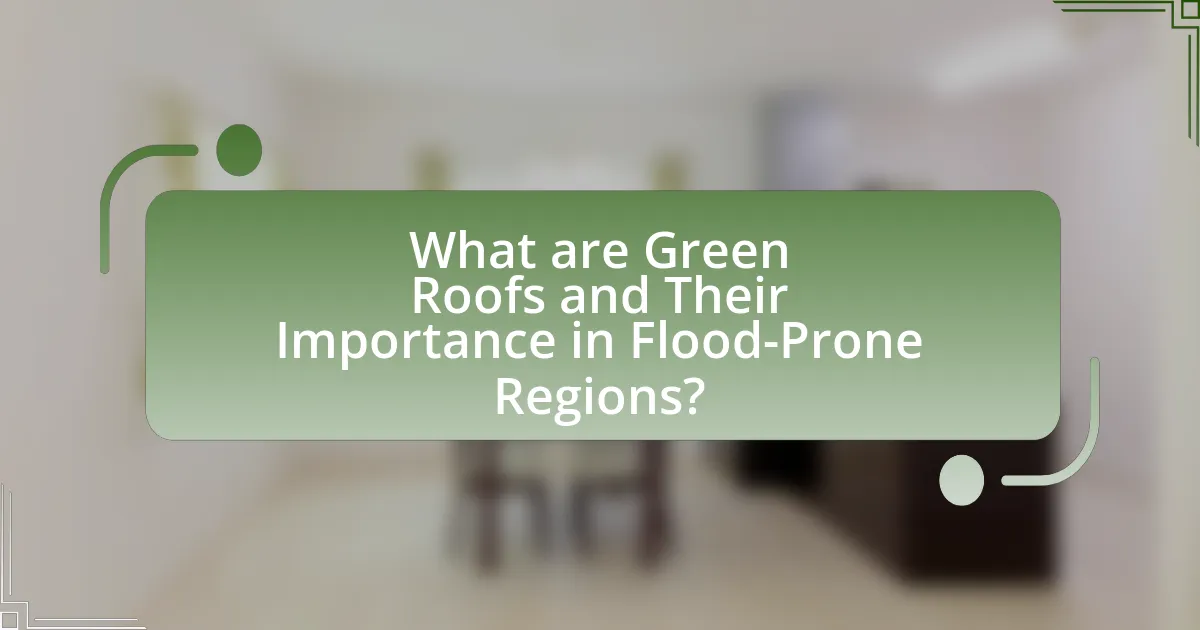
What are Green Roofs and Their Importance in Flood-Prone Regions?
Green roofs are vegetated surfaces installed on rooftops that provide numerous environmental benefits, particularly in flood-prone regions. They play a crucial role in managing stormwater by absorbing rainfall, which reduces runoff and mitigates flooding risks. Studies indicate that green roofs can retain up to 80% of precipitation during rain events, significantly decreasing the volume of water that enters drainage systems. This capacity to manage stormwater helps alleviate pressure on urban infrastructure, reduces the likelihood of flooding, and enhances urban resilience against climate change impacts.
How do Green Roofs function to mitigate flooding?
Green roofs mitigate flooding by absorbing and retaining rainwater, which reduces runoff. The vegetation and substrate on green roofs can retain up to 75% of precipitation, allowing for gradual release of water, thus decreasing peak flow rates during storms. Studies have shown that green roofs can significantly lower the volume of stormwater runoff, with some systems capable of retaining over 50% of rainfall during heavy storms. This function not only alleviates pressure on urban drainage systems but also helps prevent localized flooding and water pollution.
What are the key components of a Green Roof system?
The key components of a Green Roof system include a waterproof membrane, a root barrier, drainage layers, a growing medium, and vegetation. The waterproof membrane prevents water from penetrating the building structure, while the root barrier protects the membrane from root damage. Drainage layers facilitate excess water removal, preventing waterlogging, and the growing medium supports plant growth by providing nutrients and moisture retention. Finally, vegetation, which can include various plant species, contributes to biodiversity and helps manage stormwater runoff. These components work together to enhance the roof’s functionality and sustainability, particularly in flood-prone regions.
How do these components interact to manage stormwater?
Green roofs manage stormwater by utilizing layers of vegetation, soil, and drainage systems that work together to absorb, retain, and gradually release rainwater. The vegetation captures rainfall, while the soil layer retains moisture, reducing runoff. The drainage system facilitates controlled water flow, preventing flooding and allowing for gradual infiltration into the underlying layers. Studies show that green roofs can reduce stormwater runoff by up to 65% during peak rainfall events, demonstrating their effectiveness in managing stormwater in flood-prone regions.
Why are Green Roofs particularly beneficial in flood-prone areas?
Green roofs are particularly beneficial in flood-prone areas because they absorb and retain rainwater, reducing surface runoff. This water retention capability can decrease the volume of stormwater that enters drainage systems, thereby mitigating the risk of flooding. Studies indicate that green roofs can retain up to 75% of rainfall during peak events, significantly lowering the burden on urban drainage systems. Additionally, they promote evapotranspiration, which further reduces the amount of water that contributes to flooding.
What specific challenges do flood-prone regions face?
Flood-prone regions face significant challenges including frequent and severe flooding, infrastructure damage, and economic losses. These areas often experience heavy rainfall and rising water levels, leading to property destruction and displacement of residents. For instance, the National Oceanic and Atmospheric Administration reported that flooding causes an average of $8 billion in damages annually in the United States alone. Additionally, flood-prone regions struggle with inadequate drainage systems, which exacerbate flooding events and hinder recovery efforts. The combination of these factors creates a persistent cycle of vulnerability, making it difficult for communities to rebuild and adapt effectively.
How do Green Roofs address these challenges effectively?
Green roofs effectively address challenges in flood-prone regions by absorbing rainwater, reducing runoff, and improving stormwater management. The vegetation and soil layers in green roofs can retain significant amounts of water, with studies showing that they can capture up to 80% of rainfall during peak events. This retention helps mitigate flooding risks by slowing down the flow of water into drainage systems, thereby decreasing the likelihood of overflow. Additionally, green roofs enhance urban biodiversity and improve air quality, contributing to overall environmental resilience in flood-prone areas.
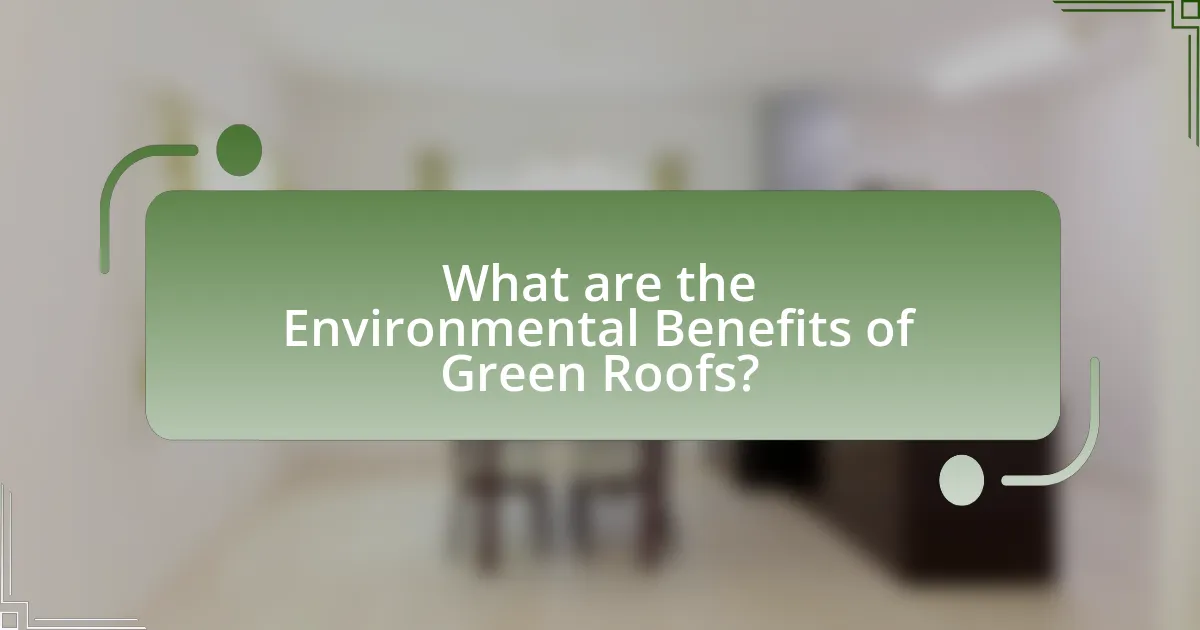
What are the Environmental Benefits of Green Roofs?
Green roofs provide significant environmental benefits, including improved stormwater management, enhanced biodiversity, and reduced urban heat island effects. They absorb rainwater, which mitigates flooding and decreases runoff, thereby reducing the burden on drainage systems. Studies indicate that green roofs can retain up to 80% of rainfall during summer months, effectively lowering the risk of urban flooding. Additionally, these roofs support various plant and animal species, promoting urban biodiversity. Research shows that green roofs can lower surrounding air temperatures by up to 5 degrees Celsius, contributing to cooler urban environments and improved air quality.
How do Green Roofs improve urban biodiversity?
Green roofs improve urban biodiversity by providing habitats for various plant and animal species in densely populated areas. These green spaces create microhabitats that support pollinators, birds, and other wildlife, which are often scarce in urban environments. Research indicates that green roofs can host a diverse range of flora, with studies showing that they can support up to 150 different plant species, enhancing local biodiversity. Additionally, green roofs contribute to ecosystem services such as improved air quality and stormwater management, further benefiting urban wildlife.
What types of plants are typically used in Green Roofs?
Succulent plants, sedums, and native grasses are typically used in green roofs. These plants are chosen for their drought resistance, low maintenance needs, and ability to thrive in shallow soil conditions. Research indicates that sedums, such as Sedum album and Sedum spurium, are particularly effective due to their water retention capabilities and adaptability to varying climates, making them ideal for green roofs in flood-prone regions.
How do these plants contribute to local ecosystems?
Plants on green roofs contribute to local ecosystems by enhancing biodiversity, improving air quality, and managing stormwater. These plants provide habitats for various species, including birds and insects, which increases local biodiversity. Additionally, they absorb carbon dioxide and release oxygen, thus improving air quality. Furthermore, green roofs help manage stormwater by absorbing rainfall, reducing runoff, and mitigating flooding, which is particularly beneficial in flood-prone regions. Studies have shown that green roofs can reduce stormwater runoff by up to 75%, demonstrating their effectiveness in ecosystem contribution.
In what ways do Green Roofs enhance air quality?
Green roofs enhance air quality by filtering pollutants and absorbing carbon dioxide. The vegetation on green roofs captures particulate matter, such as dust and smoke, which improves overall air cleanliness. Additionally, plants engage in photosynthesis, converting carbon dioxide into oxygen, thereby increasing oxygen levels in urban environments. Studies indicate that green roofs can reduce urban heat islands, which in turn lowers the formation of ground-level ozone, a harmful air pollutant. For instance, research published in the journal “Environmental Science & Technology” demonstrates that green roofs can reduce airborne particulate matter by up to 60%.
What pollutants can Green Roofs help filter from the air?
Green roofs can help filter pollutants such as particulate matter, carbon dioxide, nitrogen oxides, and volatile organic compounds from the air. Studies have shown that the vegetation and substrate in green roofs capture and retain these pollutants, improving urban air quality. For instance, a study published in the journal “Environmental Science & Technology” found that green roofs can reduce particulate matter by up to 60% and significantly lower levels of nitrogen oxides, demonstrating their effectiveness in mitigating air pollution.
How does improved air quality benefit urban populations?
Improved air quality benefits urban populations by reducing respiratory and cardiovascular diseases. Studies indicate that lower levels of air pollutants, such as particulate matter and nitrogen dioxide, lead to significant health improvements. For instance, research published in the journal Environmental Health Perspectives found that a 10 µg/m³ reduction in particulate matter can decrease hospital admissions for respiratory issues by 0.5% to 1%. Additionally, enhanced air quality contributes to better overall mental health and increased productivity among urban residents, as cleaner air is linked to lower stress levels and improved cognitive function.
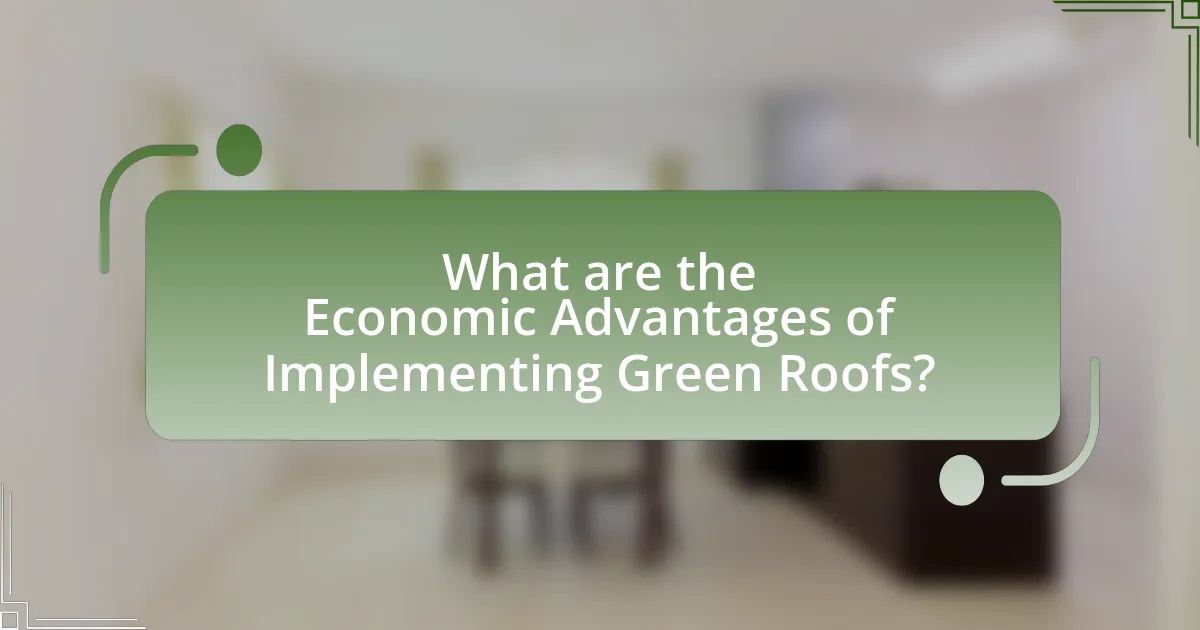
What are the Economic Advantages of Implementing Green Roofs?
Implementing green roofs offers significant economic advantages, including reduced energy costs, increased property value, and stormwater management savings. Green roofs provide insulation, which can lower heating and cooling expenses by up to 25%, as reported by the National Research Council of Canada. Additionally, properties with green roofs often see an increase in market value, with studies indicating a rise of 5-15% in urban areas. Furthermore, green roofs can mitigate stormwater runoff, leading to reduced costs for stormwater management systems, which can save municipalities and property owners thousands of dollars annually.
How do Green Roofs contribute to energy savings?
Green roofs contribute to energy savings by providing natural insulation, which reduces the need for heating and cooling in buildings. The vegetation and soil layers on green roofs absorb sunlight and moderate temperature fluctuations, leading to lower energy consumption. Studies indicate that green roofs can reduce indoor temperatures by up to 5 degrees Celsius during summer months, significantly decreasing air conditioning costs. Additionally, they can lower heating costs in winter by retaining heat within the building. This dual effect of temperature regulation results in energy savings of approximately 25% in some cases, as reported by the National Research Council of Canada.
What is the impact of Green Roofs on building insulation?
Green roofs significantly enhance building insulation by providing an additional layer of thermal resistance. This layer reduces heat transfer, leading to lower energy consumption for heating and cooling. Studies indicate that green roofs can lower indoor temperatures by up to 5 degrees Celsius in summer and reduce heating demands in winter, thus improving overall energy efficiency. Furthermore, the vegetation and soil on green roofs retain moisture, which contributes to thermal regulation and mitigates temperature fluctuations.
How do energy savings translate into financial benefits for property owners?
Energy savings translate into financial benefits for property owners primarily through reduced utility bills and increased property value. By implementing energy-efficient solutions, such as green roofs, property owners can lower their heating and cooling costs significantly; studies indicate that green roofs can reduce energy consumption by up to 25%. Additionally, properties with green roofs often see an increase in market value, with some reports suggesting a premium of 5% to 15% over comparable properties without such features. This combination of lower operational costs and enhanced property value demonstrates a clear financial advantage for property owners investing in energy-saving technologies.
What are the potential cost savings associated with Green Roofs?
Green roofs can lead to significant cost savings primarily through reduced energy expenses, stormwater management costs, and extended roof lifespan. Studies indicate that green roofs can lower heating and cooling costs by 25% to 50% due to improved insulation and reduced urban heat island effects. Additionally, they can mitigate stormwater runoff, potentially saving municipalities and property owners up to 50% on stormwater management fees by decreasing the volume of water that needs to be treated. Furthermore, the lifespan of a traditional roof can be extended by 20 years or more when a green roof is installed, resulting in lower replacement costs over time.
How do Green Roofs reduce stormwater management costs?
Green roofs reduce stormwater management costs by absorbing and retaining rainwater, which decreases the volume of runoff entering drainage systems. This absorption can reduce peak flow rates by up to 75% during heavy rainfall events, thereby minimizing the need for expensive stormwater infrastructure upgrades. Additionally, studies have shown that green roofs can retain approximately 60% of annual rainfall, significantly lowering the burden on municipal stormwater systems and reducing the costs associated with managing stormwater runoff.
What financial incentives are available for Green Roof installation?
Financial incentives for Green Roof installation include tax credits, grants, and rebates offered by federal, state, and local governments. For example, the Federal Investment Tax Credit allows property owners to deduct a percentage of the installation costs from their federal taxes. Additionally, many municipalities provide grants or rebates to encourage green infrastructure, with some cities offering up to $10 per square foot for green roof installations. These financial incentives aim to promote sustainable practices and reduce urban flooding, aligning with environmental goals and improving community resilience.
What are the best practices for designing and maintaining Green Roofs in flood-prone regions?
The best practices for designing and maintaining green roofs in flood-prone regions include selecting appropriate plant species, implementing effective drainage systems, and ensuring regular maintenance. Choosing native and drought-resistant plants enhances resilience to flooding while minimizing water usage. Effective drainage systems, such as built-in overflow outlets and retention layers, prevent water accumulation and reduce the risk of structural damage. Regular maintenance, including monitoring plant health and cleaning drainage systems, ensures optimal performance and longevity of the green roof. These practices are supported by studies indicating that well-designed green roofs can significantly mitigate stormwater runoff, thereby reducing flooding risks in urban areas.
What design considerations should be taken into account for effective flood management?
Effective flood management requires the integration of sustainable design practices, such as the implementation of green roofs. Green roofs absorb rainwater, reducing runoff and mitigating flooding risks. Studies indicate that green roofs can retain up to 80% of rainfall during peak events, significantly lowering the volume of water entering drainage systems. Additionally, incorporating native vegetation enhances soil permeability and promotes biodiversity, further contributing to flood resilience. Urban planning must prioritize these features to create effective flood management strategies that adapt to climate change and urbanization challenges.
How can maintenance practices enhance the longevity and effectiveness of Green Roofs?
Maintenance practices enhance the longevity and effectiveness of green roofs by ensuring optimal plant health, structural integrity, and efficient water management. Regular activities such as weeding, irrigation, and fertilization promote healthy vegetation, which is crucial for the roof’s insulation and stormwater management capabilities. For instance, a study by the University of Toronto found that well-maintained green roofs can retain up to 75% of rainfall, significantly reducing runoff and mitigating flooding risks. Additionally, periodic inspections and repairs of the waterproof membrane prevent leaks and structural damage, further extending the lifespan of the green roof system.
